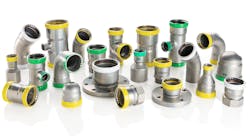Jim Harris
Special to Contractor
FIFTY YEARS AGO, in 1954, it was business as usual in the bathroom products industry. The industry was maturing as the population was moving away from “the Saturday night bath” to more regular bathing habits.
In the United States, cleanliness was becoming a cultural habit, particularly with the return of GIs from World War II, where in basic training camps they were taught to shower every day.
Eljer, which had been founded in 1904, saw little dramatic change in the first half of its existence, aside from its invention of the vitreous china tank and the growth of the bathroom products business in general.
In the early 1950s, the concept of showering vs. bathing was rapidly gaining in popularity, particularly among males. Showerheads were installed over bathtubs, along with large, circular rings to hold shower curtains. Single-handled faucets and shower diverters were not as yet invented, so there were usually two handles for the tub water and two more for the shower.
Four major manufacturers dominated the bath fixture industry at the time, with Crane considered to be in the lead. The other three were American Standard, Eljer and Kohler.
The standard color was white, and bathrooms were all sold in collections or sets from one fixture manufacturer. Toilets were primarily 5-gal. models, sinks were all vitreous china with legs and bathtubs were primarily cast iron, although steel was available. Faucets, showerheads and other accessories were usually all brass, typically in chromium and gold finishes.
Vanities were yet to come. Showrooms that displayed these products were hard to find. Catalogs were the main selling vehicle.
There was little importing of products in any sector, with the United States as a whole jealously guarding its manufacturers. In the plumbing industry, foreign products as a whole were anathema.
Then in the 1960s, the major fixture manufacturers began experimenting with color. Kohler was a leader in this effort with its campaign entitled “The Bold Look of Kohler.” It introduced fixtures in vivid colors, including bright red. Eljer and the other manufacturers also began focusing more attention on fixtures in colors, motivating wholesalers to begin opening their first showrooms to display these more exciting products to contractors and their customers.
Also during the latter part of the 1960s, Universal-Rundle introduced the first fiberglass shower/tubs, and it struggled to get the industry to accept a plasticized product. When home builders began asking for the product, the category began to take off, both for homes and the hospitality industry.
For the most part, the major bath fixture manufacturers ignored the category, opening it to a bevy of new vendors who used small manufacturing facilities, and even barns, to spray-mold the products. Acrylics were added to the mix shortly thereafter.
At about the same time, shower doors were coming into vogue to enclose the new plastic fixtures or coated steel shower stalls. Further, bathroom vanities were becoming popular, and the drop-in sink was added to the product lineup of the sink manufacturers, with most of the sinks still being manufactured out of vitreous china.
By the mid-1970s, the concept of the bathroom collection from a single manufacturer began to be challenged. It was no longer unusual to see only the toilet and sink from a major bath fixture manufacturer, with the tub/ shower units made by other vendors.
In the late 1970s, the first major import products arrived, notably from Grohe, which had a difficult time breaking through the barrier of the wholesaler and contractor mentality of stocking and selling foreign-made product lines.
Then following the recession of 1981-82, the great kitchen and bath revolution began in earnest, dramatically increasing the revenues of many of the major domestic manufacturers and inducing a flood of foreign-made products, particularly in higher-end faucets and cabinetry. The industry anathema to foreign-made products quickly began to disappear.
As the revolution picked up steam, the National Kitchen Association changed its name to the National Kitchen & Bath Association, as many of its independent dealers began adding bath vignettes to their showrooms and the association added bath design to its training programs.
At the same time, plumbing wholesaler showrooms grew not only in number but also in sophistication. As the manufacturers began to add stock-keeping units in a flood of designs and colors, they needed their wholesalers to display and promote them in expanded and well-designed showrooms.
For the American homeowner, having a new bath with all the latest designs, bells and whistles became a status symbol. In some homes, the bathroom became the dominant room.
Then in the mid to late 1980s, the major retailers, including many now defunct home center chains as well as The Home Depot and Lowe’s, began carrying major brand names in the bath products industry.
The exposure of live product to millions of shoppers in the home centers appeared to reinforce the momentum of the bath revolution, which continues to this day, as exemplified by the Kitchen/Bath Industry Show, which this year attracted more than 40,000 industry professionals and 900 exhibitors. Such a show in 1954 would probably have attracted fewer than 75 exhibitors.
For the bath fixture manufacturers, including Eljer, it’s been quite a ride.
Jim Harris is president of Eljer Plumbingware.

